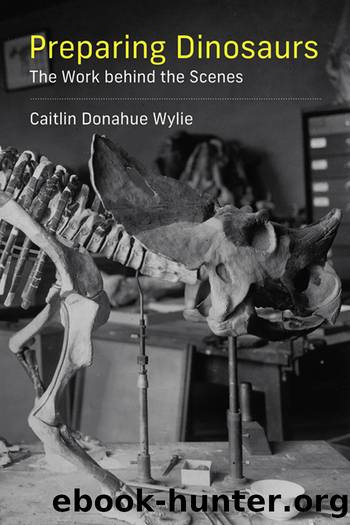Preparing Dinosaurs by Wylie Caitlin Donahue;

Author:Wylie, Caitlin Donahue; [Wylie, Caitlin]
Language: eng
Format: epub
Publisher: MIT Press
Published: 2021-08-11T00:00:00+00:00
The Symbiosis of Researchers and Preparators
Researchers do not reject CT outright; most interviewees told me that CT should be used alongside specimens in a mixed-methods approach. According to Sam, the most âfruitfulâ research method is a combination of âCT and the human eye, an expert eye,â on a physical fossil. By highlighting the limitations of CT, researchers show their preference for the flexibility and reliability of âexpertâ eyes.
So whose eyes are expert? Research workers recognize and appreciate each otherâs trained judgment, not just researchersâ. For example, like Brochu, Maurice doubts that CT can replace the information a preparator learns about specimens while preparing them: âI know lots of examples of preparators discovering things in fossils, just by virtue of the fact that theyâre so intimately involved with the specimen. And they might say, âDo you want this cleaned out?â And itâs like, âWhat is that? I never saw that beforeâ [laughs]. And that kind of thing happens a lot, so itâs hard to imagine not having that anymore.â Mauriceâs appreciation for preparatorsâ input reflects the symbiosis of the many kinds of fossil work and workers. Researchers depend on preparatorsâ work, which depends on researchersâ funding, all of which rely on the care and organization of specimens by conservators and collection managers (Wylie 2019b).
Perhaps because of this interdependence, preparator Bill framed his answer to whether CT can replace preparation in terms of people: âYou do need to see the fossil and have a CT scan at the same time. I donât think weâll ever really be able to get rid of preparators. Might be able to cut back on the number you need, but I think there always will be a need for them as long as thereâs paleontologyâpaleontologists.â Based on his own interestsâpreserving his jobâas well as researchersâ need to see the fossil, Bill justifies why preparators and researchers are inseparable. When he changed his response from paleontology to paleontologists, Bill indicated an underlying connection specifically between these kinds of workers rather than between preparators and fossil research. Workers define their work and roles relative to each other, as opposed to relative to a process of research or specimen care. If CT were to replace preparation and thus preparators, this network of social roles and divided labor in labs would collapse. As merely an additional tool, however, CT does not threaten the status quo.
By rejecting CT as a panacea for fossil research, research workers reinforce the technologyâs perceived role as exterior to the fossil lab community. They worry about adding another field to the work of preparing and studying fossils, perhaps in the interest of preserving their current community. CT, after all, requires different skills, training, and tools than a prep lab can provide. Preparator Steve views this as a significant disadvantage of CT: âYouâve got to have someone to understand all the information youâre getting out. You donât just get a lovely three-dimensional image, you have to take all that information and then merge it all together and decide on the resolution, how much youâre going to have a contrast between the bone and the rock.
Download
This site does not store any files on its server. We only index and link to content provided by other sites. Please contact the content providers to delete copyright contents if any and email us, we'll remove relevant links or contents immediately.
Technical Art History by Jehane Ragai(230)
The Slavic Myths by Noah Charney(187)
Drawing Landscapes by Barrington Barber(172)
Simply Artificial Intelligence by Dorling Kindersley(164)
Drawing for the Soul by Zoë Ingram(157)
The Art of Painting Sea Life in Watercolor by Maury Aaseng Hailey E. Herrera Louise De Masi and Ronald Pratt(150)
Compacts and Cosmetics by Madeleine Marsh(145)
The Art of Portrait Drawing by Cuong i(145)
Preparing Dinosaurs by Wylie Caitlin Donahue;(138)
Egyptian art by Jean Capart(133)
A text-book of the history of painting by Van Dyke John Charles 1856-1932(127)
Winslow Homer by Shibutani Baku(123)
Through Japan with Brush & Ink by Chiura Obata(108)
Pornoterrorism: De-Aestheticising Power by Louis Armand Jaromir Lelek(103)
Botanical Illustration by Valerie Price(102)
Culture and Ideology under the Seleukids by Eva Anagnostou-Laoutides Stefan Pfeiffer(102)
Jane Evans. Chinese Brush Painting. A Complete Course in Traditional and Modern Techniques by Unknown(94)
The Dali Legacy by Christopher Heath Brown(92)
Medieval and Renaissance Fashion by Raphaël Jacquemin(91)
